| Marine
Organism |
Description |
 |
Fusulinid.
Fusulinids are foraminifera (single-celled eukaryotes, that is
complex cells) which originated in the Ordovician (see the geological
time scale), and flourished in the Carboniferous and Permian.
Those at the end of the Permian were the largest that ever lived,
some about the size of grains of rice; others even larger (up
to several cm/more than an inch). Their skeletons are calcium
carbonate. Most lived on the seafloor (that is, they were benthic),
though some species probably floated in the open water (that
is, they were pelagic). Some presumably contained symbiotic algae,
which helped provide essential nutrients. The fusulinids went
extinct at the end of the Permian, but many other foraninifera
(known as forams) are around today. (Newell, 1978, p. 115, drawing.) |
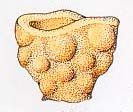 |
Raphidonema. A sponge. Sponges use flagellae (tiny, hair-like
appendages) to pump water through their bodies, capturing food
particles along the way. Some sponges have skeletons of fibrous
material (these are the ones used as bath sponges), others have
glass skeletons (see the Venus flower basket, in the Early Triassic
aftermath section), and still others, like Raphidonema,
have calcium carbonate skeletons. These are referred to as calcisponges.
Raphidonema lived during the Triassic and Cretaceous Periods,
and was about 8 cm (just over 3 inches) tall. (Walker and Ward,
1992, p. 34, drawing.) |
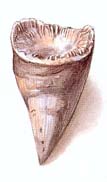 |
Rugose coral.
Rugose corals are distant relatives of today's corals (scleractinians),
and even more distant relatives of jellyfish and sea anemones
(they are all classified as cnidarians, pronounced NY-dare-ee-ans).
They first appear in the Ordovician; the last of them disappear
at the end of the Permian, though most had already gone extinct.
This is the calcium carbonate (calcite) skeleton of a solitary
rugose coral, which could reach a meter (yard) in length. Some
species were colonial; these could be as much as 4 meters (yards)
across. With living tissue, they may have resembled sea anemones.
(Busbey, 1996, p. 211, drawing.) |
 |
Tabulate coral.
Tabulate corals were colonial, and like rugose coral colonies,
could attain 4 meters (yards) in diameter. They also had calcium
carbonate (calcite) skeletons. This drawing shows a tabulate
coral from above; each compartment contained a small, sea anemone-like
member of the colony. Arose in the Ordovician; extinct at the
end of the Permian. (Newell, 1978, p. 115, drawing.) |
 |
Scleractinian
coral. These are today's corals, having evolved after the end-Permian
extinction (in the Triassic). This staghorn coral (Acropora)
is just one of many very different kinds of scleractinian corals.
Most have a calcium carbonate skeleton (here aragonite rather
than calcite). Coral reefs (of which the staghorn is often a
prominent member) are only found within about 25° of the
equator. Reef-building corals contain symbiotic algae (zooxanthellae,
pronounced zose-an-THELL-ee), which help provide nutrition. (Newell,
1978, p. 115, drawing.) |
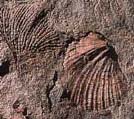 |
Bryozoan and
Brachiopod. The meshlike fossil in the upper left is a byrozoan.
Bryozoans are colonial organisms, that is, numerous individuals
work together, sweeping the seawater for fine, floating particles
of food. The meshlike structure contains chambers for the individual
members of the colony; as with fusulinids, this skeleton is composed
of calcium carbonate. Though many orders of bryozoans went extinct
at the end of the Permian, one made it through, and its descendants
thrive today. (The shell is that of a brachiopod, and is discussed
below: see Cyrtina.) (Busbey, 1996, p. 213, photo.) |
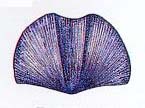 |
Cyrtina. Brachiopods may look like ordinary sea shells
(see Aviculopecten, below), but they are not. Note that
the shell, as seen from above, is symmetrical, whereas Aviculopecten's
is not. The internal anatomy of brachiopods is also quite different
from ordinary sea shells (mollusks), and they are therefore assigned
to their own phylum. Cyrtina, which belonged to a group
of brachiopods called spirifers (a common fossil in New York
state), lived from the Devonian to the Permian. The shell in
the photo above is also a spirifer, but not necessarily one of
Cyrtina. Cyrtina's shell was about 5 cm (about
1 1/2 inches) across. (Walker and Ward, 1992, p. 88, drawing.) |
 |
Archaeocidaris. This sea urchin lived from the Early Carboniferous
to the Permian. Sea urchins (echinoids) are echinoderms ("spiny-skins,"
for the calcite plates which cover their bodies), and, like their
fellow echinoderms the sand dollars and starfish (sea stars),
display a five-fold (pentameral) symmetry. Sea urchins have long
spines for protection, but even longer 'tube feet,' long, thin,
but retractable appendages they use for locomotion. They scrape
their dinners from off rocks. Archaeocidaris was about
8 cm (3 inches) in diameter. (Walker and Ward, 1992, p. 176,
drawing.) |
 |
Deltoblastus. The end of the Permian extinction took the
last of the blastoids, of which Deltoblastus is one. Like
sea urchins, blastoids are echinoderms. They held on to the seafloor
with rootlike appendages called holdfasts, and swept the currents
with arm-like appendages for food particles, which they transported
to their mouths along long grooves. The stalk in this illustration
has been cut to indicate that it is longer than the picture size
will allow. Cup (top) diameter was about 1.5 cm (3/5 inch). (Walker
and Ward, 1992, p. 190, drawing.) |
 |
Eocrinus. Though superficially resembling blastoids
like Deltoblastus, Eocrinus was a crinoid, a different
group altogether, though both blastoids and crinoids are echinoderms.
The outstretched arms of crinoids have given the popular name
sea lilies. They are a common fossil in the limestones of the
American Midwest. Like blastoids, they gathered food particles
from the water, and were attached to the seafloor with holdfasts.
They were decimated at the end of the Permian, and perhaps only
one genus made it through to the Triassic, but its descendants
are still around today. Cup diameter
was about 2.5 cm (1 inch). (Walker and Ward, 1992, p. 171, drawing.) |
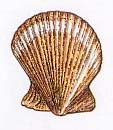 |
Aviculopecten. Pectens (scallops) are extremely common mollusks,
of the group known as bivalves. The term 'valve' here refers
to a shell; clams too are bivalves. Note that the calcium carbonate
shell is not symmetrical, distinguishing it from the brachiopods.
Aviculopecten lived from the Carboniferous to the Permian.
Diameter was about 2.5 cm (1 inch).
(Walker and Ward, 1992, p. 98, drawing.) |
 |
Bellerophon. Bellerophon belonged to the group of
mollusks (gastropods, that is, "stomach-feet") that
we commonly call snails. Gastropods live in seawater, freshwater,
and on land. They have shells of calcium carbonate (usually aragonite),
and make their livings rasping food off rocks and plants. Bellerophon
lived from the Silurian though to the Early Triassic, thus escaping
extinction (for a short time) at the end of the Permian. They
were typically about 7.5 cm (3 inches) in length. (Walker and
Ward, 1992, p. 115, drawing.) |
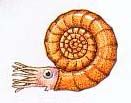 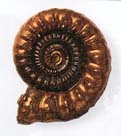 |
Bifericeras. Though some ammonites grew to about two meters
(yards) in diameter, Bifericeras was just a little guy,
about 3 cm (1 1/4 inches) in diameter. Ammonites resembled today's
squids, but with coiled shells. Indeed, they are squid and octopus
relatives, and capture prey in similar fashion: with their long
tentacles. Squids, octopi, ammonites, and nautiloids (like today's
chambered nautilus) are all cephalopods ("head-feet"),
the smartest of the mollusks. The ammonites had several brushes
with oblivion: having arisen in the Devonian Period, they barely
made it through the extinction event near the Devonian's end
but fared well thereafter; only three families made it through
the end of the Permian, but again, they thrived through the Mesozoic
Era, only to finally succumb to extinction at the end of the
Cretaceous.
This specimen is the female; the male was smaller and less ornate.
Bifericeras lived during the Early Jurassic. Below the
drawing is a photograph of a spectacular pyritized specimen:
under the right conditions, fossils may become pyritized, that
is, partially replaced by iron pyrite ("fool's gold,"
FeS¸2), making them look like they have been poured
from melted gold. (Walker and Ward, 1992, p. 150, drawing and
photo.) |
 |
Trilobites.
Trilobites, the "bugs" of Paleozoic seas, are arthropods
("jointed feet"), and thus the distant relatives of
modern insects, spiders, scorpions, crabs, lobsters, and crayfish.
Their external skeletons (called exoskeletons) are made of chitin,
a hard protein material similar to that of fingernails. Named
for their three "lobes," clearly visible in the segmented
sections of these two specimens, they flourished from the Cambrian
to the extinction event of the Late Devonian Period, though they
managed to survive into the Carboniferous and Permian. The last
of the trilobites perished at the end of the Permian. Some trilobites
were tiny -- only a millimeter (1/25th of an inch) -- but others
reached a full meter (yard) in length. (Busbey, 1996, p. 221,
photo.) |
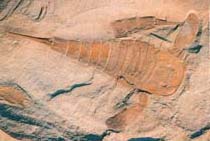 |
Eurypterid.
Eurypterids were arthropods, relatives of today's horseshoe crabs.
They date from the Ordovician Period, though somewhat similar
organisms may be traced back to the Early Cambrian. The end-Permian
extinction killed off the eurypterids. The appendages that look
like paddles really were paddles: they were used for swimming.
And yes, those are eyes. This photograph includes the tail end
of one eurypterid as well as a complete specimen. (Busbey, 1996,
p. 223, photo.) |
| Terrestrial
Flora |
Description |
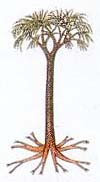 |
Lepidodendron.
Lepidodendron was among the first of the tree-like plants. Members
of the lycopods ("club mosses"), which emerged in the
Silurian Period and has survived to the present day, with notable
changes along the way. Toady's lycopods are small plants that
appreciate damp conditions; their earliest ancestors were similar.
But in the middle of the Paleozoic Era they became dominant members
of the first forests, reaching 40 meters (130 feet) in height.
Lepidodendron was a cone-bearing Carboniferous lycopod, but others
remained important forest constituents until they were replaced
by other trees like Archaeopteris. (Walker and Ward, 1992, p.
294, drawing.) |
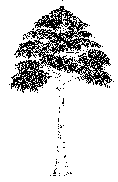 |
Archaeopteris.
Another tree of the first forests, Archaeopteris was a progymnosperm.
Conifers are gymnosperms, so progymnosperms were conifer ancestors.
Its fern-like fronds originally convinced paleobotanists that
it was a fern, until the connection between the fronds and fossil
tree stumps measuring up to a meter and a half (5 1/2 feet) in
diameter was discovered. Then Archaeopteris, at up to 10 meters
(33 feet) tall, was recognized as the fern-tree progenitor of
the conifers, and all other seed-bearing plants as well. (Stewart
and Rothwell, 1993, p. 266, drawing based on reconstruction by
Beck, 1962.) |
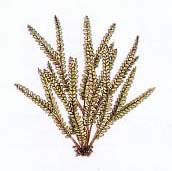 |
Dicroidium. In this drawing, Dicroidium looks like
a small plant. Actually, it was not so small: about 4 m (13 feet)
high. True ferns produce spores, but Dicroidium, a seed
fern, produced seeds. It lived during the Triassic, and thus
was a descendant of the survivors of the Permian extinction.
Its own descendants likely included the cycads. Fern trees and
seed ferns are the main constituents of the coal beds dating
from the appropriately named Carboniferous. (Walker and Ward,
1992, p. 299, drawing.) |
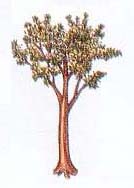 |
Glossopteris. Like Dicroidium, Glossopteris
was a seed fern, but of tree size and shape. With long, tongue
or sword-like leaves, it was quite widespread in the forests
of Gondwana during the Permian. Despite this success, however,
it was wiped out at the end of the Permian, though some related
organisms (part of the Glossopteris flora) survived through
the Triassic. This Glossopteris purportedly reached about
8 meters (26 feet) in height; other species (that is, members
of the same genus) may have been shorter: see the drawing in
the discussion of the Glossopteris flora in the Permian
world section. But the two pictures of Glossopteris look
quite dissimilar, so the differences may be attributable to varying
paleontological or artistic interpretations. (Walker and Ward,
1992, p. 297, drawing.) |
 |
Conifer. Conifers
make cones, hence their name. They are gymnosperms, meaning that
they have "naked," relatively unprotected, seeds. Though
they evolved prior to the end of the Permian, that extinction
event eliminated many gymnosperm competitors. Seizing their new
opportunity, conifers thrived in the Mesozoic, and have ever
since. Conifers include pines, firs, and spruces, major components
of colder region forests. (Walker and Ward, 1992, p. 303, drawing.) |
 |
Ginkgo. Ginkgoes
are gymnosperms, like conifers and cycads, but instead of having
needles or fronds, they have broad leaves. They arose in the
Early Permian, and survived the extinction event to thrive in
the Triassic Period and especially the Jurassic. Known for the
often unpleasant odor of their fruit, Ginkgoes are still around
today. Unlike most other trees, which have both male and female
organs on the same plant, each tree is either male or female.
Ginkgoes are quite tall, and reach as much as 35 meters (115
feet) in height. (Walker and Ward, 1992, p. 307, drawing.) |
| Terrestrial
Fauna |
Description |
 |
Eryops. This large (175 kg/ almost 400 pounds) amphibian
lived during the Early Permian Period, and attained a length
of 1.5-2 m (5- 6 1/2 feet). Eryops probably lived both
on land and in the water. It belonged to a group called the labyrinthodonts,
and more specifically to the temnospondyls. (Lambert, 1985, p.
94, drawing.) |
 |
Diplocaulus. This Permian Period amphibian (a lepospondyl)
was smaller than it may look, being only about 1 m (39 inches)
in length. Its unusual wide, flat skull has attracted much conjecture;
one suggestion is that it prevented potential predators from
easily swallowing the animal. A series of fossils shows that
the skull shape of Diplocaulus's ancestors gradually widened
with time. (Walker and Ward, 1992,
p. 221, drawing.) |
 |
Aphaneramma. A fish-eating, early Triassic amphibian. Like
today's alligators and crocodiles, and especially gharials (all
of which are reptiles, not amphibians), Aphaneramma's
elongated snout allowed it to get close to prey before its bulk
revealed its presence. It was about 2 m (6 1/2 feet) in length.
(Walker and Ward, 1992, p. 222, drawing.) |
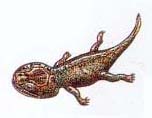 |
Batrachosuchus. This amphibian lived in the Triassic; like
Diplocaulus, it had an enlarged, flattened skull. It was
smaller than Diplocaulus, however, and only reached about
half a meter (20 inches) in length. (Walker and Ward, 1992, p.
223, drawing.) |
 |
Scaphonyx. Scaphonyx belonged to the rhynchosaurid
("beak-lizard") family of the rhynchocephalians ("beak-heads").
Though they possessed no ordinary teeth, their tusk-like beaks
allowed them to gather vegetation which they crushed with strong
toothplates in their palates. They lived during the Middle of
the Triassic, and reached about 1.8 m (6 feet) in length and
about 90 kg (200 pounds) in weight. (Lambert, 1985, p. 115, drawing.) |
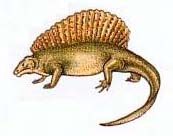 |
Edaphosaurus. A "sail-back" reptile. Edaphosaurus
was a distant, herbivorous relative of today's mammals. The "sail"
was most likely a primitive method of heat regulation. By orienting
the sail to catch the morning rays of sunshine, Edaphosaurus
could raise its body temperature much more rapidly than could
other reptiles, allowing it to move about and feed earlier in
the day. Its higher metabolism would also have assisted it in
outrunning potential predators. It evolved in the Late Carboniferous
Period, and lived into the Early Permian. 3 m (10 feet) in length.
(Walker and Ward, 1992, p. 256, drawing.) |
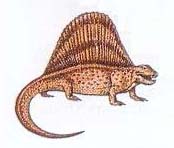 |
Dimetrodon. Because it looks big and nasty -- which it
was -- Dimetrodon is often mistaken for a dinosaur. Actually,
this "sail-back" reptile (like Edaphosaurus,
a pelycosaur) lived -- and died off -- tens of millions of years
before the dinosaurs. It lived in the Early Permian, and was
a formidable predator, perhaps on Edaphosaurus!
At about 3 m (10 feet) in length, Dimetrodon was about the same size as Edaphosaurus,
and lived during the Early Permian as well. (Walker and Ward,
1992, p. 255, drawing.) |
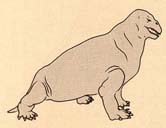 |
Moschops. A mammal-like reptile; one of the therapsid
group (specifically, a dinocephalian). Mammals, birds, and likely
at least some of the dinosaurs are all warmed-blooded creatures.
Actually, they are classified as endotherms, which means that
they regulate their own internal temperatures, unlike the ectotherms
("cold-blooded" organisms), whose internal temperatures
are about the same as their surroundings. Moschops was
a big guy (about 2.4 m/ 8 feet long; weight about 700 kg/1500
pounds) with a massive skeleton and sprawling limbs. (Nonetheless,
it was a vegetarian.) It lived during the Middle of the Permian.
(Lambert, 1985, p. 132, drawing.) |
 |
Therapsid.
This is a sort of generic therapsid, obviously different from
the massive Moschops. (It does, however, resemble Thrinaxodon,
or perhaps Pristerognathid, a carnivorous Late Permian
therapsid weighing in at about 50 kg/110 pounds.) Some therapsids
possessed snout pits, from which long, whisker-like hairs could
have protruded (think of your cat!). If so, at least some therapsids
may have had body hair, which would have helped keep them warm
and possibly allowed them to live in colder conditions. Therapsids
included several groups of mammal-like reptiles, including the
Dinocephalians (like Moschops), Dicynodonts, and the Cynodonts,
from which modern mammals evolved. Note how this therapsid does
not possess the sprawling limbs of Moschops, and with
limbs upright, was likely more efficient at getting about than
its ancestors. Therapsids were, by far, the most successful and
numerous of the Late Permian land animals. (Madsen and Troll,
1994. p. 56, drawing by Ray Troll.) |
 |
Lystrosaurus. An Early Triassic therapsid. It has been suggested
that Lystrosaurus was comparable to today's wild pigs,
or perhaps a smaller version of a hippo. Certainly there were
plenty of them around, snarfing up lots of vegetation, cropping
it with their strong, almost toothless jaws. They may have been
semi-aquatic, and fed on aquatic plants. About 2 m (6 1/2 feet)
in length. (Norman, 1994, p. 117, drawing.) |
 |
Euparkeria. An archosaur (Triassic), about half a meter
(1 1/2 feet) in length. Just before the end of the Permian, the
dominant land animals were incontestably the therapsids. Other
land animals, mostly other lines of reptiles, paled to relative
insignificance. The end-Permian extinction reshuffled the existing
biota, and allowed some of these other reptiles to usurp the
reigning therapsids. Most important, by far, was that group known
as the archosaurs. Soon after the extinction, the archosaurs
exploded into prominence (the name archosaurs means "ruling
lizards"). Indeed, their descendants would rule the world
for over a hundred million years, and drive the proto-mammals
into smaller sizes and more marginal habitats. These descendants
were the dinosaurs. (British Museum, 1985, p. 50, model.) |
































